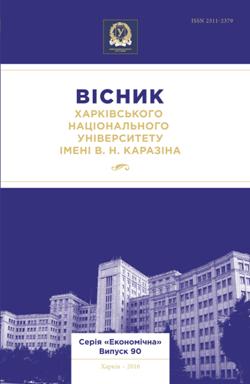Interaction of the public and market sectors of economy in the structure of public-private partnership
Abstract
Advantages and disadvantages of both market and public sectors of economy are analyzed in this article. Limits to regulate the economic processes in the situations with externalities and fabrication of the “public goods”, give the reason to form the concept, which is called “fiasco of the market”. Elimination of the fiasco consequences was entrusted on the state. Active government participation was implemented in the form of regulation of economic decisions as well as in the form of state enterprise. Public sector subjects in the economy are state enterprises, joint – stock companies, economic companies with the
public share in the nominal capital.
Low efficacy of the state sector is conditioned by the high transaction expenses, not rational utilization of the budget means, rent-seeking behaviour of the government employees, leads to the “fiasco of the state”. The way to counter this is the process of the privatization. However privatization itself doesn’t provide the effectiveness of the economy. Public enterprises can perform some important stabilizing function. Optimal combination of public and private sectors is necessary. It allows to smooth the shortcomings of each of them. The best variant of such interaction is reached by means of achieving public-private partnership, which forms and methods provide the high economic effectiveness.
Relations in the sphere of public-private partnership reflect the special interaction of the state and private sectors subjects. Distribution of the authorities between these sectors determines different models of public-private partnership: concessions, agreement of product division, joint enterprises, special economic zones and technopolis that suppose different variants of the cooperation.
In Ukraine the mechanism of the public-private partnership is at the stage of formation and is one of the way of the market transformations.
Downloads
References
2. Делмон Д. Государственно-частное партнерство в инфраструктуре: практическое руководство для органов государственной власти / Д. Делмон. – Астана.: АО Казахский Центр государственно-частного партнёрства, 2010. – 250 с.
3. Четвериков Е. Л. Публично-приватное партнёрство как социально-экономический институт / Е. П. Четвериков // Экономическая теория – 2009. – № 4. С. 31–40.
4. Корнаи Я. Дефицит / Я. Корнаи. – М.: Наука, 1990. – 607 с.
5. Время. – 2016. – 24 марта.
6. Радыгин А. Провалы государства: теория и практика / А. Радыгин, Р. Энтов. – М.: Вопросы экономики – 2012. – № 12. С. 4-30.
7. Public – Private Partnerships. Fiscal Risks and Fiscal Institutions in the EU8 The World Bank. 21 March [Еlectronic resource]. – Way of asses: http://www.worldbank.org. (Last access 21.03.2011)
8. Варнавский, В.Г. Государственно-частное партнёрство [Электронный ресурс]. / В. Г. Варнавский. – Режим доступа : http://www.opec.ru/article_doc
9. Про державно-приватне партнерство: Закон України від 01 липня 2010 р. № 2404 – VI [Електроний ресурс].– Режим доступу : http://zakon4.rada.gov.ua/laws/show/2404-17

